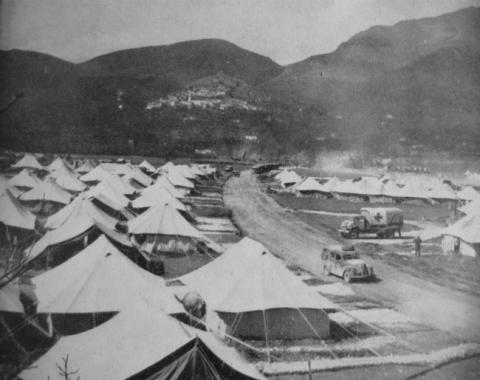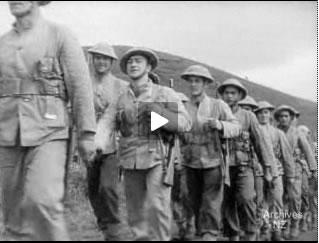<p>Footage of the Māori Battalion in training 22 October 1943.<br /><br />See Tumanako Thompson at 1:15</p>
Media library
Video
<p><strong>Veteran Ralph Tako, whose first language is Maori, recalls the break-out at Minqar Qaim and reminsces about comrades on a C Company veterans’ pilgrimage to Italy in 1999. There were over 150 participants in the group, including 18 veterans, travelling on three buses. Ralph is talking to Monty Soutar. His first language is Maori.</strong></p><h2><strong>Transcript</strong></h2><p><strong>Ralph Tako</strong>: ...well like ah... too many battles you can’t say which.</p><p><strong>Monty Soutar:</strong> Oh ae, ae</p><p><strong>Ralph Tako: </strong>Only the breakthrough, I remember the breakthrough</p><p><strong>Monty Soutar:</strong> Minqar Quaim?</p><p><strong>Ralph Tako:</strong> Well, it was C Company that broke the line. Yeah. And we lost one of the officers [referring to Capt. Jim Tuhiwai]. Tutu Wirepa was our officer but before that battle goes, we never carried a spade, or pick or anything, a gas mask … the line has to be broken [referring to the breakout at Minqar Qaim] but the sappers had to get [i.e. lay] the mine first and then we always attack about one o’clock.</p><p><strong>Monty Soutar:</strong> In the morning?</p><p><strong>Ralph Tako:</strong> Yeah, always the morning. *And all the, see we were [on] the move then see … they showed us [when] we broke the line Pakeha comes to be stretcher bearers. Maoris would prepared [i.e. ordered] again to join. Aww, you gotta go on the book, well if a man had the timings well you can tell the places he’s been eh [meaning it would help him if he had the offical history of the Maori Battalion to refer to so as to remind himself of the dates and order of battles].</p><p>Some Maoris can compose songs, just like that song “Dusty wheels across the desert”. That fulla that composed the song is cousin to Tutu Wirepa … he was a Henderson</p><p><strong>Monty Soutar:</strong> Henderson? From Te Araroa?</p><p><strong>Ralph Tako:</strong> Yeah.</p><p><strong>Monty Soutar:</strong> You know which one?</p><p><strong>Ralph Tako:</strong> Rangi</p><p><strong>Monty Soutar:</strong> Oh he got killed eh?</p><p><strong>Ralph Tako:</strong> He got killed [at Point 209 in Tunisia], well composing, because you just don’t know where you’re going next time. How can you, because once the brigade is put in the line they got to go forward or go backwards. And that's the 6th Brigade, but always the 5th Brigade, because the best fighters were the 23rd and the 28. That’s the Pakeha’s from the South Island.</p><p><strong>*Denotes editorial break in footage</strong></p><p> </p>
<p>Nga Taonga a Nga Tama Toa Trust</p>
<p>Film by Tolaga Bay Area School student Hine Parata-Walker of the reunion of the 28th Māori Battalion held at Te Poho ō Rāwiri Marae, Turanga on 21-23 March 2008. The film includes interviews with Dr Apirana Mahuika (youngest brother of <a href="/node/1582">Nepia Mahuika</a>), <a href="/node/1997">Sir Henare Ngata</a> and <a href="/node/2447">Nolan Raihania</a>. Tini Glover (<a title="See his record" href="/node/1279">Tautini Moana Karawa</a>) is seen speaking on the marae.</p><h2>Māori Battalion Reunion 2008</h2><p>The 28th Māori Battalion Association (Gisborne Branch) hosted the National Reunion at Te Poho ō Rāwiri Marae on Easter Weekend 2008. This was one of the marae from which soldiers of the Battalion marched out during the Second World War, so there was great historical significance having the reunion there. Soldiers of the A Company (Gumdiggers), B Company (Penny Divers) and D Company (Ngāti Walkabout) arrived at Tairāwhiti and were greeted by members of the C Company (Ngā Kaupoi).</p><p>Out of the 3,600 men who served in the 28 Māori Battalion in the Second World War, 65 years later there are less than 20 C Company veterans left and no more than 60 Māori Battalion veterans throughout the country. C Company was made up of volunteers from the region between Tōrere and Muriwai, there were close to 1,000 men in the Māori Battalion from this district. Later in the year, Tairāwhiti hosted another big gathering of C Company veterans, whānau and friends at Te Poho ō Rāwiri Marae to launch the book –<em> Ngā Tama Toa: The Price of Citizenship</em> written by Monty Soutar.</p>
<p>Copyright Hine Parata-Walker</p>
<p>This 1942 <em>Weekly Review </em>film shows Māori reinforcements training in Northland before sailing overseas to join the 28th Battalion in North Africa.</p><p>A couple of B Company soldiers have been identified in the footage, at 3:05 - <a href="/node/360" target="_blank">Te Whiu Bush</a> sits at the centr of this group of 3 soldiers and <a href="/node/2017">Dick Ngoungou</a> is at the right. At 3:22 <a href="/node/665" target="_blank">Robert Gillies</a> is to the left of the open fire and again at 3:30 seated with other members of the Battalion.</p><p>Please let us know if you recognise any of the men in this film.</p>
<p>WEEKLY REVIEW No. 67, Archives New Zealand / Te Rua Mahara o Te Kāwanatanga<br />-see <a href="http://audiovisual.archives.govt.nz/wiki/index.php/WEEKLY_REVIEW_No._67…; target="_blank">full reference on their film wiki website</a></p>



